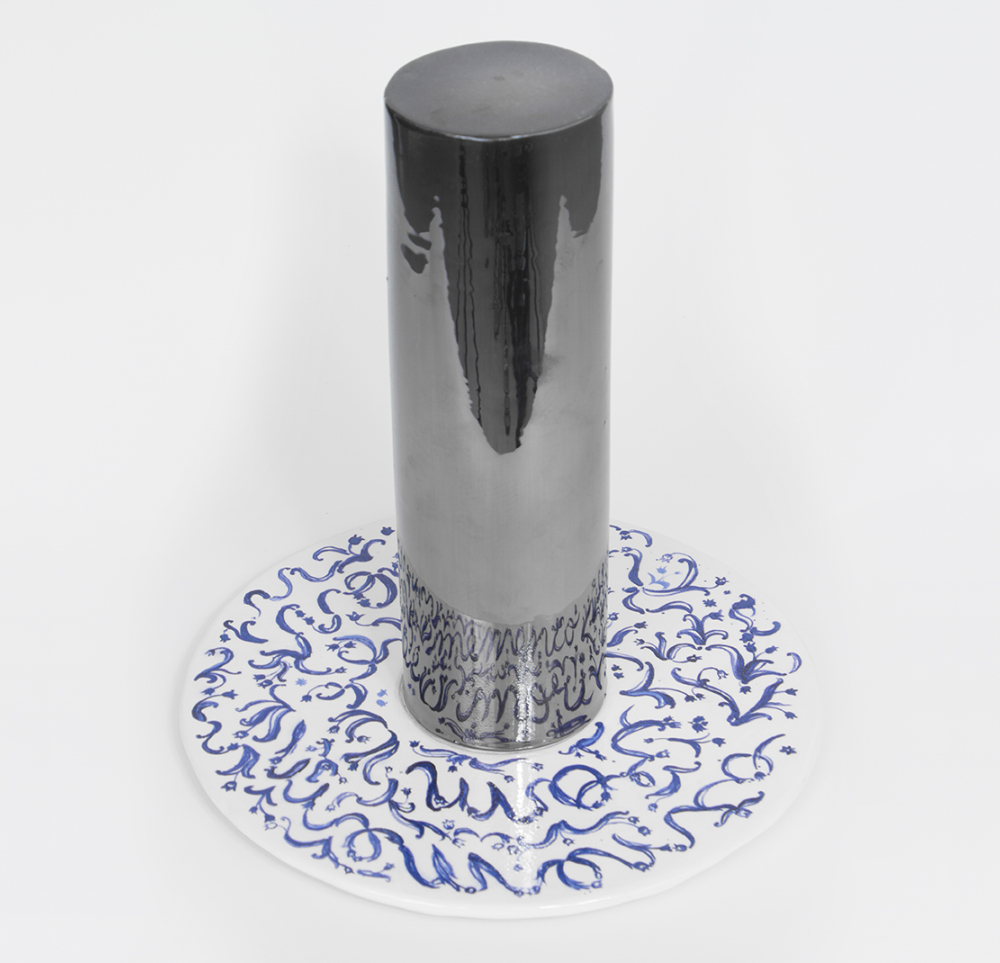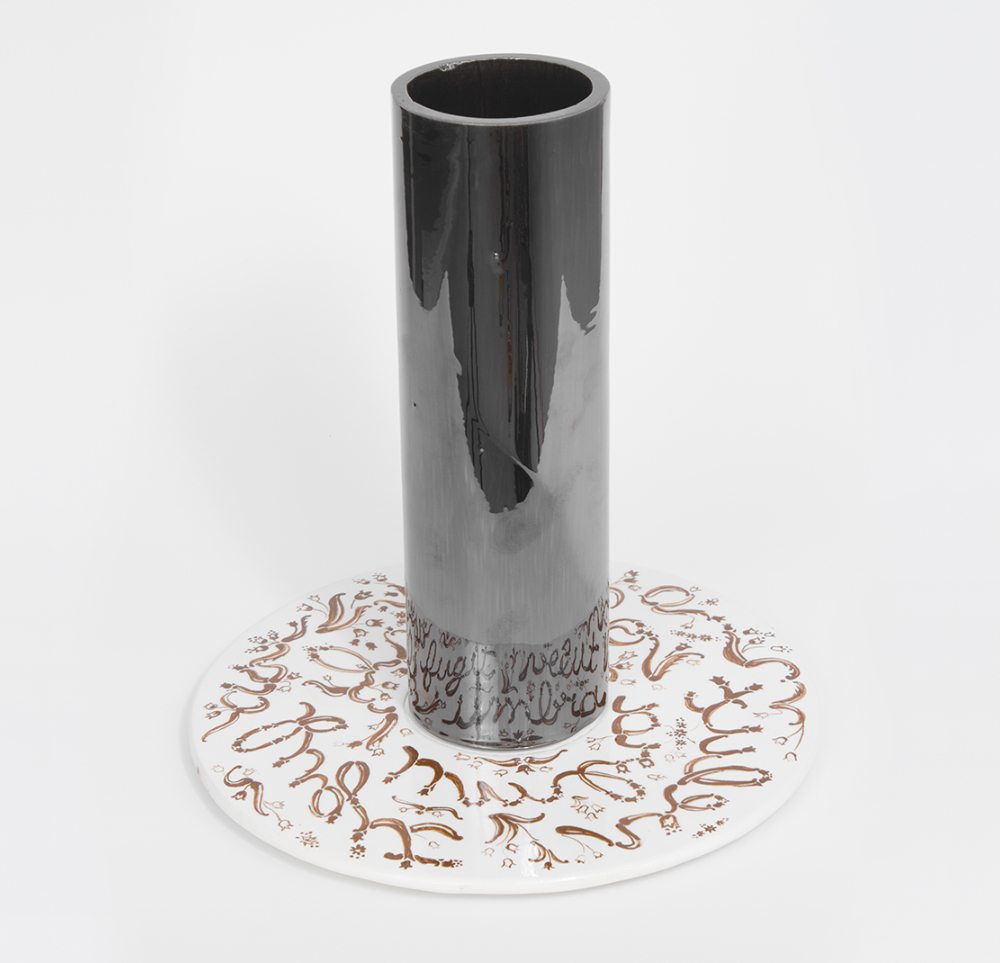Seven Erections
Talent à la carte Award 2015 - Maison & Objets design fair, Paris 2015
Schneider & Denker Galery, Berlin 2016
LB Galery, Copenhagen 2016
Enamelled earthenware, patterns and shapes realised by artist's hands.
This is the story of seven mirrors that deform reality to reveal the truth. The one that tells the story of the eternal bond between death and desire. Is there not an anamorphosis which distances the phallus from the penis?







(The thematic)
The mirror is a very curious thing. Despite being an every day object, it posseses something magical : it gives the power to see ourselves as another. However every power has its cost.
Since the trap of Narcissus, the mirror has continued to travel through literature and cinema with this fascinating paradox. This one fragments, aspires, duplicates, distorts and even causes pain while at the same time revealing truth. What a strange suggestion to conceive so truth might not be contained in reality. However, this can be corroborated if one observes our contemporaries. An opposed paradox which arises from other types of screens such as the television or computer, especially when taking into context the advent of social networking. These vehicles push the issue to the extreme and beg us to consider the notion, « more transparency for less truth ». Even so, is this still a contradiction ?
(The object)
This object presents itself, in theory, as a beautiful vase or dome (if you allow me) as decorative as it is harmless. But it is exclusively up to the owner (or the conscientious observer), who, in placing the object upon the plate, will be seized by the instant when the opportunity gives a revelation. An anamophosis suddenly appears in the reflection to unveil a recurrent latin quotation taken from ancient religious texts and poetry, as well as paintings . This translates into the theme of vanity and death in the horizon. The habits of our comforts and the relative facility of our life decor should not discourage the reader who will be taken by an despondent nihilism. On the contrary, he or she must try to discover the prime function of these « memento mori ». If people of Renaissance adorned their environment with skulls, ancients took this theme as an opportunity to value the life on earth, in the largest prism. Being moreso conscious of their death that of their life, it is up to each person to fill it with intellectual, sensible or sensual experiences. The vases of the series are pursuing otherwise this reading.The bouquet which adorns the vase, by fading, will cover the plate with its petals, gradually covering its message to substitute human language for nature.
(The set of plates)
This series is limited to seven in accordance with Edgar Allen’s story The Masque of the Red Death. Prince Prospero and high society close themselves off in a giant castle built in an exuberant gothic style. They escape the shadow of the death in excess of entertainment, while the outside world is dying from the plague. However, the castle is described as having a succession of seven rooms which allow a person to enter only room at a time. Already this suggests the idea of different life stages. Especially due to the fact that the final room where no one dares to tread is dark and contains a large ebony clock which frightens the guests at every hour despite the lively party.
(The series of vases, domes or urns)
The color of each plate corresponds to seven precise forms that follow in a precise order. Each one is represented in a geometric form which calls back archetypes of monuments whose function is to resist time. It is in this way that we advance in History : beginning at menhir, continuing then to the column, followed by the bell tower, dome, then to the industrial chimney which is followed by the tower, then with the rocket … Or also the bura funeral urn, which escorts the dead in representing the motor of life which is desire (represented here as an erect phallus). Opposition is represented in principle, then, by vertical or massive shapes and the decorative plates. However, within these harmless decorative flowers of the plates is hidden a message of vanity toward the erection, reminding the viewer that nothing lasts. One is also able to understand that these monuments resist the effects of history with difficulty.
The mirror is a very curious thing. Despite being an every day object, it posseses something magical : it gives the power to see ourselves as another. However every power has its cost.
Since the trap of Narcissus, the mirror has continued to travel through literature and cinema with this fascinating paradox. This one fragments, aspires, duplicates, distorts and even causes pain while at the same time revealing truth. What a strange suggestion to conceive so truth might not be contained in reality. However, this can be corroborated if one observes our contemporaries. An opposed paradox which arises from other types of screens such as the television or computer, especially when taking into context the advent of social networking. These vehicles push the issue to the extreme and beg us to consider the notion, « more transparency for less truth ». Even so, is this still a contradiction ?
(The object)
This object presents itself, in theory, as a beautiful vase or dome (if you allow me) as decorative as it is harmless. But it is exclusively up to the owner (or the conscientious observer), who, in placing the object upon the plate, will be seized by the instant when the opportunity gives a revelation. An anamophosis suddenly appears in the reflection to unveil a recurrent latin quotation taken from ancient religious texts and poetry, as well as paintings . This translates into the theme of vanity and death in the horizon. The habits of our comforts and the relative facility of our life decor should not discourage the reader who will be taken by an despondent nihilism. On the contrary, he or she must try to discover the prime function of these « memento mori ». If people of Renaissance adorned their environment with skulls, ancients took this theme as an opportunity to value the life on earth, in the largest prism. Being moreso conscious of their death that of their life, it is up to each person to fill it with intellectual, sensible or sensual experiences. The vases of the series are pursuing otherwise this reading.The bouquet which adorns the vase, by fading, will cover the plate with its petals, gradually covering its message to substitute human language for nature.
(The set of plates)
This series is limited to seven in accordance with Edgar Allen’s story The Masque of the Red Death. Prince Prospero and high society close themselves off in a giant castle built in an exuberant gothic style. They escape the shadow of the death in excess of entertainment, while the outside world is dying from the plague. However, the castle is described as having a succession of seven rooms which allow a person to enter only room at a time. Already this suggests the idea of different life stages. Especially due to the fact that the final room where no one dares to tread is dark and contains a large ebony clock which frightens the guests at every hour despite the lively party.
(The series of vases, domes or urns)
The color of each plate corresponds to seven precise forms that follow in a precise order. Each one is represented in a geometric form which calls back archetypes of monuments whose function is to resist time. It is in this way that we advance in History : beginning at menhir, continuing then to the column, followed by the bell tower, dome, then to the industrial chimney which is followed by the tower, then with the rocket … Or also the bura funeral urn, which escorts the dead in representing the motor of life which is desire (represented here as an erect phallus). Opposition is represented in principle, then, by vertical or massive shapes and the decorative plates. However, within these harmless decorative flowers of the plates is hidden a message of vanity toward the erection, reminding the viewer that nothing lasts. One is also able to understand that these monuments resist the effects of history with difficulty.
